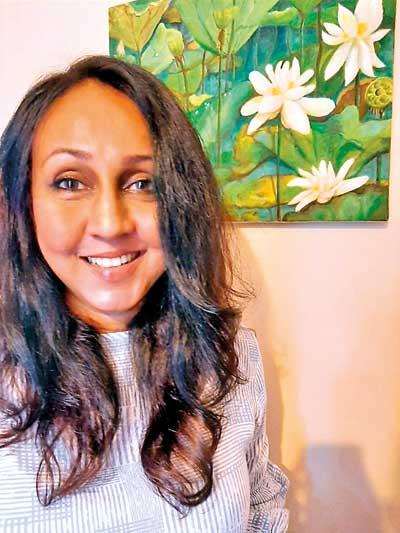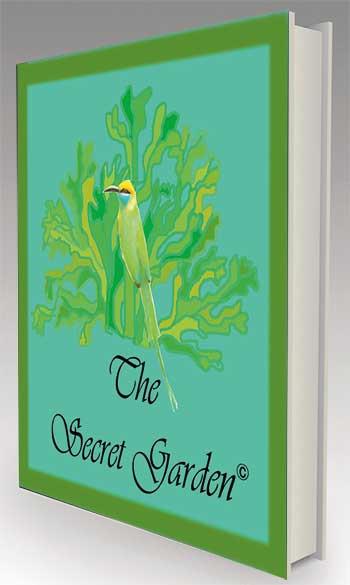21 May 2021 - {{hitsCtrl.values.hits}}
Due to stigma, adult survivors of childhood sexual abuse are reluctant to engage in the traditional methods of therapy
People use the medium of art for stress relief. We all have the ability to create and express. A person can project an innermost feeling through visual art
Art as a medium, gives expression to emotions. One need not have innate talent to paint emotions. Bare hands can serve as a great tool instead of a paint brush
ART THERAPY PRACTITIONER, PRISCILLA CAREN ANANDAPPA, 
FOUNDER : THE SECRET GARDEN, in conversation with Shanthi Wijesinghe
To live a NORMAL life after being abused under any category is a tall order. It significantly impacts daily functioning, interpersonal relationships, overall mental health and general well-being of the victim; child or adult survivor. Multiple treatment modes although utilized, all with varying degrees of success, sexually abused children and adults live through life with memories which refuse to be erased.
Due to stigma, adult survivors of childhood sexual abuse are reluctant to engage in the traditional methods of therapy provided in the mental health setting. Given societal expectations, adult male survivors of childhood sexual abuse may be even more ashamed.
Repressed emotion and/or Post Traumatic Stress Disorder (PTSD) feature hugely in this ordeal.
Of the many victims I have worked with over the years,the focus is on some specific sensory details from the assault. For example, they often remember specific smells (the smell of body odour), but very few details of other aspects: how long the assault lasted or the specific order of the event/s. These are normal limitations of memorycaused by the stress and fear of the traumatic events.It is the brain’s defence circuitry affecting attention and memory consolidation.Some fragments of a traumatic experience seem like they are “burned into” memory. This is how they are recalled. The claim, “I’ll never forget!” is a certain powerful memory of an experience, in reference to some particular aspect of it, which seems indelibly etched upon them, and have no memory of other peripheral details.
 Art as a medium, gives expression to emotions. One need not have innate talent to paint emotions. Bare hands can serve as a great tool instead of a paint brush. Splashes of colour will appear on a clean canvass. Anger, hate, shame, mistrust, fear, misery, disgust is portrayed as if the victim has been through an in-depth study. At times vibrant with strong upward strokes or watery as if a gush of rain has washed over the story. It is a good way to heal the soul.
Art as a medium, gives expression to emotions. One need not have innate talent to paint emotions. Bare hands can serve as a great tool instead of a paint brush. Splashes of colour will appear on a clean canvass. Anger, hate, shame, mistrust, fear, misery, disgust is portrayed as if the victim has been through an in-depth study. At times vibrant with strong upward strokes or watery as if a gush of rain has washed over the story. It is a good way to heal the soul.
Priscilla Caren Anandappa, studied under Violet Oaklander on Art Therapy and Arts Therapy for self-healing by Riana van Staden. She was a student at the Cora Abraham school of art and studied graphic design and creativity development at the University of Colombo. She’s currently engaged in the study of Art History. She is a qualified educator in Psychology, Child Psychology and Early Childhood Education.
 Q How does creativity help with emotionally withdrawn people?
Q How does creativity help with emotionally withdrawn people?
People use the medium of art for stress relief. We all have the ability to create and express. A person can project an innermost feeling through visual art, performance art, music, literature, poetry or the spoken word. The visual medium is of great benefit. It is not everyone who has the ability to communicate feelings. A survivor needs time to process the trauma. It may happen eventually, and art in particular, is a great starting point and an option worth considering. Art doesn’t have to be structured, or politically correct. It doesn’t have to follow any sequence or measure up to any particular standard. The artist can use symbols, colour and a variety of mediums to come up with a unique flair.
Clay has proved to be an exceptional medium. It has a therapeutic value.In both these mediums, the final outcome(painting/sculpture) is of no consequence. The product becomes a conversation starter.
Q Women and children...do they react differently to the medium? 

It’s been a cultural norm to associate art with femininity or an activity one follows as a child while at school. Think of art in a global context and you will see that men and women from historical times have been involved in art related fields.
Q What avenues of art are available to those who want to help victims?
Having access to the internet has given us the ability to select various avenues of self-expression. We can purchase knowledge, tools, materials required at the click of a button. To those who are withdrawn, socially awkward, lonely, physically challenged or have cognitive limitations, the possibilities are endless. Teachers, parents, practitioners and counsellors must access these tools to assist victims on their journey. Mental health professionals should be aware of these wonderful benefits.
Q Do we all possess ‘artistic abilities’?
I strongly believe so. During the classical period, art was critiqued and segregated according to very rigid standards with unrealistic expectations. In our system of education, these same standards were (and still are, I’m told) used to measure an artist’s worth. Many children are made to believe that they are inadequate, not talented or lack creativity.
On the other hand, children who were able to present some sort of acceptable rendering were considered less intellectual in comparison to the ones who excelled in maths, or science. Therefore, the expectation from the artist was unreasonable and challenging on many levels. The emergence and acceptance of modern art has impacted and changed how we look at art and creative abilities. Those boundaries and possibilities are being widened, blurred, pushed and challenged every day.
Q What is the approach?
Abuse varies in severity. It is important for the person to be taken away from the abusive situation to feel safe, to be able to begin the journey towards healing and restoration. It requires a professional approach in a non-judgemental and caring atmosphere. Trust is a key factor. Only then can the victim begin to think calmly. This is the stage where the mental health professional guides the victim towards other avenues such as art.
 Q Have you worked with those who have experienced a positive change?
Q Have you worked with those who have experienced a positive change?
I have worked with children and adults who have found painting to be a great source of mental stimulation and relaxation. An observation I’ve made when working with children who have repressed anger and hostility is that these emotions often resurface when natural clay is used as a medium. It draws out negative energies. There have been outbursts of laughter, tears and even violence occasionally.
Q Would you consider art as a miracle cure for those who think they cannot face another day of life?
I don’t think it can be a miracle cure but is a definite option to be explored in almost any circumstance. During the lockdown periods we used dregs of coffee, tea and whatever we could find in our homes to create art. In confined or restricted spaces, one does find ways to be creative. For those with suicidal thoughts reaching out to a practitioner of art is important.
Q Anxiety and Depression are common among abused women. How long do they take to come to terms with reinstalling confidence within?
Art, sadly, is always not the solution. It can aid in the process, but in many circumstances cannot be used in isolation. It has to be part of a collective process.
Q Some of us cannot draw a straight line...is that a deterrent towards self-help healing ?
“A line is a dot that went for a walk”, according to Paul Klee. To elaborate on that, you may walk as you please, amongst the wild grass and flowers, over rugged terrain, mountains or valleys, sandy beaches or windy paths. Our journeys are long and arduous. No one would know unless he walks in the shoes of another. The inability to conform to someone else’s expectation or interpretation of what perfection should be, or presume that a straight line is indeed a line that we need to aspire to perfect, isn’t something that should be a deterrent. Understanding this is a leap forward in our pursuit of self-help.
Q Is deep trauma depicted through particular colours?
Colour association is something that we’ve been taught from a very early age. Black is associated with evil, white with good., pink for girls, blue for boys etc. These associations can change depending on one’s culture, religion, background etc. Presuming one’s mental state based on their use of colour is not advised or recommended. In a therapy session one must not try to interpret a person’s art, but use it as a tool to facilitate discussion.
We are sure that our readers have been inspired and encouraged that Art Therapy is definitely something that should be promoted through our proposed District Networks which will immensely help both women and children who are victims of abuse, as well explained by Art Therapy Practitioner Pricilla Caren Anandappa, Founder of The Secret Garden ([email protected])
Please sign up today to get involved in setting up a Network in your district, committed to stand against abuse of Women and Children of Mother Lanka.
Avanka Lanka Foundation
Tel; 0112863429 Email [email protected]
Website www.avankalanka.org
26 Nov 2024 26 Nov 2024
26 Nov 2024 26 Nov 2024
26 Nov 2024 26 Nov 2024
26 Nov 2024 26 Nov 2024
26 Nov 2024 26 Nov 2024